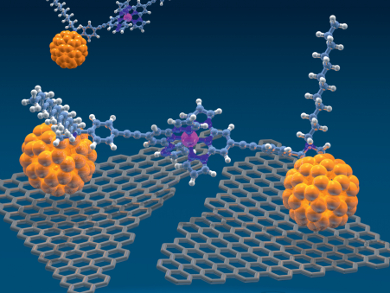A main objective in molecular electronics is building electronic devices in which each of the active moieties is made from individual molecules. Such magnetic single-molecule junctions (SMJs) bridge the gap between metal electrodes and consist of a functional unit, molecular wires, and anchoring groups.
Gold electrodes are usually used for this. However, they have certain disadvantages, such as the simultaneous anchoring of several molecules and the coexistence of different molecular orientations. Graphene nanoelectrodes can also be used in SMJs. They can provide ultra-flat, transparent, and robust devices. Suitable anchoring groups for such SMJ are C60 derivatives, which are more selective than the conventionally used thiol or amine groups.
Andreas Hirsch and colleagues, Universität Erlangen-Nürnberg, Erlangen, Germany, have performed the first synthesis of octahedrally coordinated magnetic complexes of FeII or CoII with two highly π-conjugated linkers (phenylethynyl, bisphenylethynyl, or naphthylethynyl) and two C60 anchoring groups (pictured).
The compounds were studied by NMR spectroscopy. Variable-temperature NMR experiments showed free rotation around the CH–phenyl and restricted rotation around CH–naphthyl linkages. The restriction is due to steric hindrance between C60 and the π-conjugated derivative. According to the researchers, this new family of compounds is promising for the development of SMJs using graphene nanoelectrodes.
- Synthesis of Magnetic Molecular Complexes with Fullerene Anchor Groups,
Andreas Hirsch, Edurne Nuin, Walter Bauer,
Eur. J. Org. Chem. 2016.
DOI: 10.1002/ejoc.201601356
Nanoscale soccer balls help researchers pin single-molecule wires from Research Square on Vimeo.




